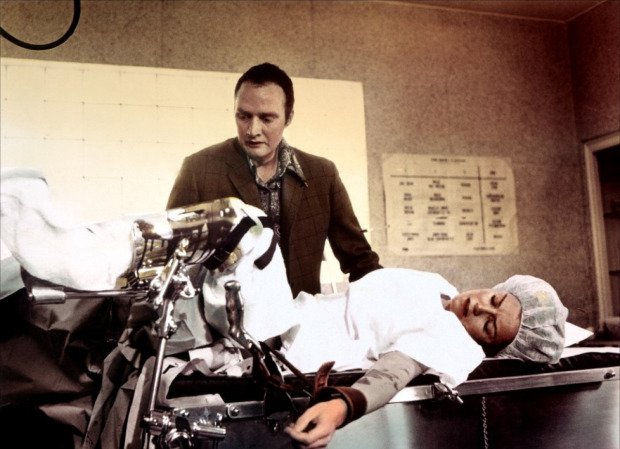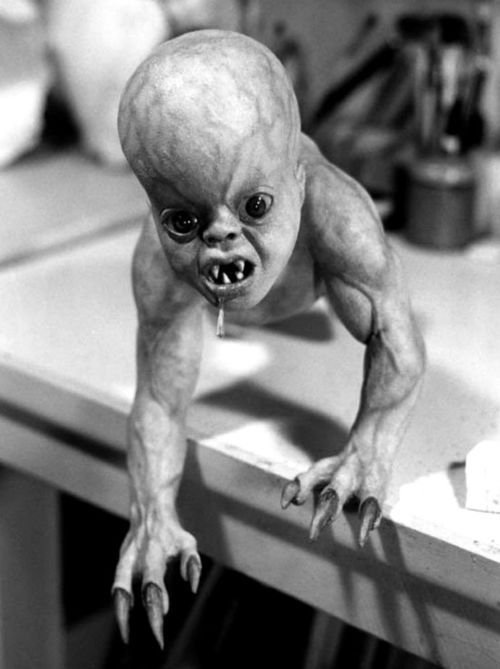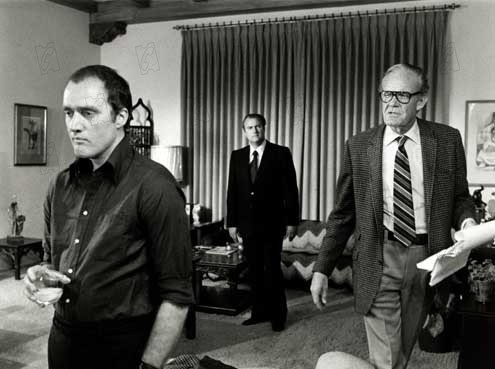IT'S ALIVE (1974): Horror As A Family Enterprise
Larry Cohen is one of the most distinctive filmmakers to emerge from the low-budget arena. His rough-hewn directing style often divides fans and critics alike but there’s no denying the unique nature of his approach to genre filmmaking. He has a unique knack for combining unusual concepts with odd humor, timely social themes  and raw, potent drama. One of the best, most effective examples of this signature blend is It's Alive, a fusion of primal parental fears and classic monster movie style.It's Alive begins in a straightforward, almost documentary-style fashion as it chronicles a family preparing for the birth of their second child. Frank (John P. Ryan) and his wife Lenore (Sharon Farrell) are very happy to be expanding their family but Lenore is unnerved about her labor pains, noting they are much more intense than they should be. She grows more distressed as the doctors ignore her warnings that “something is wrong.”If only she knew how right she was. The baby is an unearthly looking beast with fangs and claws and it slaughters every doctor and nurse in the delivery room before escaping. Soon stoic policeman Lt. Perkins (James Dixon) is plotting to kill the baby and a heartless doctor (Shamus Locke) is figuring out how to make this tragedy play to his own scientific, careerist advantage. Frank is at first drawn into the hunt to regain his sense of n
and raw, potent drama. One of the best, most effective examples of this signature blend is It's Alive, a fusion of primal parental fears and classic monster movie style.It's Alive begins in a straightforward, almost documentary-style fashion as it chronicles a family preparing for the birth of their second child. Frank (John P. Ryan) and his wife Lenore (Sharon Farrell) are very happy to be expanding their family but Lenore is unnerved about her labor pains, noting they are much more intense than they should be. She grows more distressed as the doctors ignore her warnings that “something is wrong.”If only she knew how right she was. The baby is an unearthly looking beast with fangs and claws and it slaughters every doctor and nurse in the delivery room before escaping. Soon stoic policeman Lt. Perkins (James Dixon) is plotting to kill the baby and a heartless doctor (Shamus Locke) is figuring out how to make this tragedy play to his own scientific, careerist advantage. Frank is at first drawn into the hunt to regain his sense of n ormality but discover some surprising things about the meanings of family and fatherhood as the film moves toward an unearthly father/son reunion.It's Alive is not the slam-bang creature feature its premise might suggest because Cohen directs his tale with admirable subtlety. For instance, he limits the screen time of the film’s Rick Baker-designed monster baby. This subtle-old school approach greatly enhances the effectiveness of both the creature design and the film’s concept. He also works in some effective odd humor to occasionally give the audience a break from the somber storyline: one of the best moments is a scene of expectant fathers casually discussing the dangers of the world they are bringing children into.
ormality but discover some surprising things about the meanings of family and fatherhood as the film moves toward an unearthly father/son reunion.It's Alive is not the slam-bang creature feature its premise might suggest because Cohen directs his tale with admirable subtlety. For instance, he limits the screen time of the film’s Rick Baker-designed monster baby. This subtle-old school approach greatly enhances the effectiveness of both the creature design and the film’s concept. He also works in some effective odd humor to occasionally give the audience a break from the somber storyline: one of the best moments is a scene of expectant fathers casually discussing the dangers of the world they are bringing children into.  Along the way, Cohen’s sense of social consciousness brings out a number of fascinating thematic concerns that prompt his nightmarish scenario. The many serious subjects the film touches on include the role of drugs in modern pregnancy, the heartless nature of science, the need for big businesses to cover their mistakes at all costs and society’s habit of stigmatizing its unusual members while also trying to profit from their misfortune.More importantly, Cohen puts a focus on the human drama element of his tale and this approach brings a psychologically potent edge to the proceedings. It's Alive remains resonant today because Cohen draws his tale from the age-old fears of parents – fear of having a deformed or disabled child, fear that one’s child will become a killer, fear of being unequipped to be a parent and the fear of having to see one’s own child die. Cohen smartly plays to these parental fears by setting many of his major suspense setpieces in places associated with the innocence of childhood – a baby’s nursery, a classroom, a maternity ward, etc.
Along the way, Cohen’s sense of social consciousness brings out a number of fascinating thematic concerns that prompt his nightmarish scenario. The many serious subjects the film touches on include the role of drugs in modern pregnancy, the heartless nature of science, the need for big businesses to cover their mistakes at all costs and society’s habit of stigmatizing its unusual members while also trying to profit from their misfortune.More importantly, Cohen puts a focus on the human drama element of his tale and this approach brings a psychologically potent edge to the proceedings. It's Alive remains resonant today because Cohen draws his tale from the age-old fears of parents – fear of having a deformed or disabled child, fear that one’s child will become a killer, fear of being unequipped to be a parent and the fear of having to see one’s own child die. Cohen smartly plays to these parental fears by setting many of his major suspense setpieces in places associated with the innocence of childhood – a baby’s nursery, a classroom, a maternity ward, etc. The film’s dramatic component is aided considerably by an effective pair of lead performance by underrated character actors John Ryan and Sharon Farrell. Ryan effectively underplays at the outset, gradually working in a greater intensity of emotion as his character moves from confusion to anger to an understanding of his bizarre situation. Farrell adds effective support, giving the film its heart as a woman who suffers an emotional breakdown but never loses her moral compass or sense of motherly compassion.Longtime fans will also appreciate the presence of Cohen regulars Andrew Duggan and James Dixon: Duggan gets a fun cameo as a scientist trying to lay a claim on the baby’s remains and Dixon gets one of his best roles in a Cohen film as the chilly but devoted cop trying to end the killing spree.
The film’s dramatic component is aided considerably by an effective pair of lead performance by underrated character actors John Ryan and Sharon Farrell. Ryan effectively underplays at the outset, gradually working in a greater intensity of emotion as his character moves from confusion to anger to an understanding of his bizarre situation. Farrell adds effective support, giving the film its heart as a woman who suffers an emotional breakdown but never loses her moral compass or sense of motherly compassion.Longtime fans will also appreciate the presence of Cohen regulars Andrew Duggan and James Dixon: Duggan gets a fun cameo as a scientist trying to lay a claim on the baby’s remains and Dixon gets one of his best roles in a Cohen film as the chilly but devoted cop trying to end the killing spree. Despite this subtle, drama-oriented approach, It's Alive doesn’t skimp on horror movie style or creepy moments. Cohen brings plenty of atmosphere to the film via Fenton Hamilton’s moody photography, which makes effective use of nocturnal settings and shadowy interiors to create an ominous, often claustrophobic mood. This mood is taken to the next level by a sparingly used but very effective score by the late, great Bernard Herrmann, who brings some Hitchcockian ‘sturm und drang’ to the film with a minimalist yet powerful combination of strings, brass and analog synthesizer.Using these tools, Cohen achieves some genuinely chilling moments, including a nerve-frazzling scene where Frank’s older son finally meets his brother and a dramatic finale set in the Los Angeles storm drains. Without giving away details, Cohen also achieves one of the more effective false-scare scenes you'll ever see. Overall, Cohen’s effective combination of emotion, psychology and shock tactics helps It's Alive transcend its humble origins to become a true classic of 1970’s horror filmmaking.
Despite this subtle, drama-oriented approach, It's Alive doesn’t skimp on horror movie style or creepy moments. Cohen brings plenty of atmosphere to the film via Fenton Hamilton’s moody photography, which makes effective use of nocturnal settings and shadowy interiors to create an ominous, often claustrophobic mood. This mood is taken to the next level by a sparingly used but very effective score by the late, great Bernard Herrmann, who brings some Hitchcockian ‘sturm und drang’ to the film with a minimalist yet powerful combination of strings, brass and analog synthesizer.Using these tools, Cohen achieves some genuinely chilling moments, including a nerve-frazzling scene where Frank’s older son finally meets his brother and a dramatic finale set in the Los Angeles storm drains. Without giving away details, Cohen also achieves one of the more effective false-scare scenes you'll ever see. Overall, Cohen’s effective combination of emotion, psychology and shock tactics helps It's Alive transcend its humble origins to become a true classic of 1970’s horror filmmaking.


